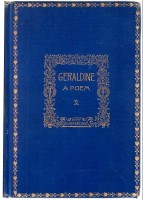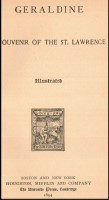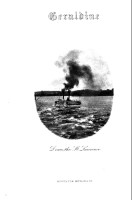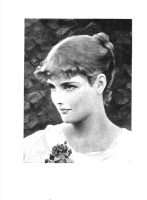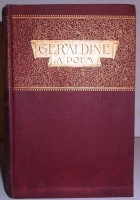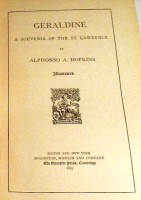Alphonso Alva Hopkins' Geraldine
Editions and Reviews of the Book
For general information on this book and its author, please junp to Geraldine
Announcements of Geraldine's 1881 Publication
The Canadian Methodist Magazine, Toronto: Briggs, XIV:July-December 1881 p557-561. GERALDINE—A SOUVENIR OF THE ST. LAWRENCE. Boston: Jas. R. Osgood & Co. Toronto: Wm. Briggs; pp. 321. "This Poem is published anonymously. We hazard the conjecture that the writer is probably T. B. Aldrich. [Sic: apparently Briggs was Osgood's Canadian distributor).
IT is not so often that our land is made the theme of song or story that we can be indifferent to such an event when it does occur. The volume above mentioned is the most notable poem descriptive of Canadian scenery which has yet seen the light. But with such a noble theme, we feel sure that it will not be the last. Canadian readers especially should give a warm welcome to this book, not only for its distinguished poetic merit, but also from a patriotic pride in the scenes which it so vividly describes. The story briefly is this: Percival Trent, a young poet, author, and lecturer, is betrothed to a high-souled Christian woman, Geraldine Hope. During a summer holiday on the St. Lawrence, he is thrown much in the company of Mrs. Lee, a lady of singular fascination. Before he is aware, a spell is upon him, with which he struggles manfully, but for a time in vain. His betrothed, aware of his estranged affection, releases him from his engagement, when he discovers the priceless pearl he has lost, and seeks, and at last successfully, to regain it. This, however, is the merest outline.' Many dramatic and even tragical incidents heighten the interest and serve to work out the plot of the story. The analysis of character, the expression of intense emotion, lofty Christian faith, and the triumph of the latter over cynical skepticism, make the book an admirable pyschological study. We have space for only a few extracts in illustration of the style of the author. The following is a description of our own beautiful St. Lawrence :---
----------------'Tis the river of dreams.
You may float in your boat on the bloom-bordered streams,
Where its islands like emeralds matchless are set,
And forget that you live, and as quickly forget
That they die in the world you have left, for the calm
Of content is within you, the blessing of balm
Is upon you forever. Blessed river that smiles
In such beauty and peace by the beautiful isles.
The description of running the rapids is a vivid piece of word painting, but is too long to quote more than a single sentence :—
----------------------Through the leaping
And boiling and thundering waves, they went sweeping
And surging, a sense as of rapidly sinking
Within them, a tardy and cowardly shrinking,
From fury still madder to come. And yet faster
They sweep through this turbulent hell of disaster,
Where ruin and wreck seem for ever at home.
The following is part of the description of Quebec :—
--------------------The next morning the height
Of historic Cape Diamond first greeted his sight,
And above the gray walls of the citadel hung
The tricolour of Britain. A battle-ship swung
By its anchor, asleep in the harbour below.
The bright roofs of the city took dazzle and glow
From the sun but just risen. Without haze, or the fleck
Of a cloud, the sky shone upon silent Quebec.
------------------------- He slipped
From the new to the old; for the centuries waited
Here once; and since then have been always belated.
As up to the gate from the river you climb,
You go back a long cycle or two into time.
------------------------- The ghosts
Of dead heroes yet walk the high battlements round it;
Red fame has a place where men sought it and found it;
Still grim and defiant re-echo the guns
That in silence have slept through a century’s suns;
In the cry of the sentry a dim challenge calls,
Out of long-buried lips from the citadel’s walls;
The wild music of musketry breaks on the air,
Where the gamer is death for the gallant who dare;
And above all the present’s calm quietude reigns
The fierce tumult of strife upon Abraham's Plains.
---------------- You feel when you stand
On the parapet yonder, as though in a land
Of dim yesterdays fled; and you walk the quaint street
As if certain some knight mediaeval to meet;
And you listen to mass in the Jesuit piles
Of the priests, as if monks moved about in the aisles
From the far middle-ages. Poor priest-ridden people!
If only there lifted some truth-telling steeple
To point the true way they must go! But the spire
Of the Jesuit never points heavenward much higher
Than the head of the prelate or priest; and the soul
Of the dead or the dying must pay proper toll,
Or go seeking its paradise long.
The description of the River Saguenay is very fine :—
-------------------------- If the silence of God ever falls
In its tenderness down on the world from the walls
Of the City of Gold, they have known it who sailed
Through the Saguenay’s stillness.
---------------- Cape Eternity grandly uprearing
Its dome to the azure, invited their nearing,
And thrilled them with awe of its might so tremendous.
Cape Trinity opposite, lifted stupendous
And mighty its masses of granite to greet
The sublimity facing it. Sailing beside
Their huge granite upheavals, the pomp and the pride
Of humanity fade to forgetting, in awe
Of the Infinite Presence that never man saw
But on mountains majestic and lonely. The lift
Of their faces is Godward; and sudden and swift
Is the leap of our thought from each adamant crown
To the Spirit Eternal that loving bends down
With a glad benediction forever.
It will be seen that the somewhat difficult rhythm is managed with rare felicity. We confess we think it less suited for the manifold needs of a long poem like this than the noble blank verse of Mrs. Browning’s “Aurora Leigh,” which can breathe low like a lute or peal like a clarion. This rippling verse, while admirably suited for simple narrative or gay persiflage, seems unequal to the expression of deep and earnest feeling. Yet the author has overcome this difficulty with remarkable success, and in Geraldine Hope has portrayed one of the noblest and sweetest characters in literature —- one of whom he says :—
There are heroines kneeling alone
In their holy of holies, or sitting unknown
Where the multitudes worship, whose offerings, made
In the silence of faith seldom doubting, have paid
Dearer tribute than incense of patriarchs.
This is how she takes leave, in a letter, of the man she has loved, but whom she now gives up for another :—
Let me kiss you farewell, as a sister might kiss you
Who felt that for years she must want you and miss you.
Forgive the hot tears that will fall on your face.
I am heart-worn and weak; but the pitying grace
Of our Father will strengthen me. Into your eyes
Let me look once again, while the saddest good-byes
That I ever have wept trickle over my cheeks,
And my love its last picture for memory seeks.
Breathe a prayer with me now that not always between
The dear picture and me shall be tears.—- GERALDINE.”
Her whole soul is ennobled by the loftiest Christian faith, and this is how she meets the argument of one who has lost his trust in God:
--------------------------“Do you never
Have doubts of the Master ? —in all your endeavour
To touch Him for healing of soul, when you press
To His side in despair of ought else?”
------------------------- “I were less
A weak woman, and more like a saint, could I hold
To my faith without doubting ever. We must doubt,
I suppose, being human ; and heartsick, without
Any help of ourselves, we too often must stem
The thick crowd of our doubts and our fears, ere the hem
Of the Healer’s soft garments we touch.”
----------------- “And you feel
That the Master walks always near by, and will heal,
If you press through the throng to His side? Though unseen,
You are sure He is there?”
------------------“There are times when between
Him and me I can see only darkness; but still
I believe I shall find Him through doing His will
And He never is lost. It is I who have strayed
From the way that He journeys, I seek Him, afraid
Till I hear His quick question ‘Who touched me?’ and then I am glad.”
The poet-soul that, like Adam, has wandered forth from his Paradise of happy love, thus sings his weary plaint in one of the many sweet lyrics of the tale :—
The way is long, O Lord, that leads
To cooling springs and fragrant meads :
I weary of its weary length;
I lose all heart and hope and strength,
As here I halt my tired feet
And pray for rest so far, so sweet.
I thank Thee for a halting-place
Made glad by Thine own smiling face;
I thank Thee that the dusty way
Thy footstep knoweth day by day ;
I thank Thee that some path there be
From pain and care to peace and Thee.
I know my times are in Thy hand;
I long for light to understand
How Thou canst for each pilgrim care,
How Thou canst hear each pleading prayer,
How unto Thee each soul is known
As if it walked the world alone.
And some time I may comprehend,
The way is long ; but at its end
A clearer vision waits the sight.
In Thy dear garden of delight,
Wayfaring done, let me abide
Where never falls an eventide.”
After wandering long on the mountains and in the deserts of Edom, to use a favourite figure of the author, he reached at last the Promised Land of peace and happiness :—
---------------- “In reverent, final surrender
Of each unto each, they uplifted the burdens
Borne separate long, to grow glad with the guerdons
Of victory sweeter than any they knew
Who are never twin-sou1ed; so at last would they go
In the strength of each other and God to the end,
Seeing each within each truest lover and friend.”
The Publishers' Weekly No. 506, 24 September 1881. "Weekly Record of New Publications." Geraldine, a souvenir of the St. Lawrence. Boston: James R. Osgood & Co., 1881. 321 p. 8vo cl $1.25. A narrative poem by an anonymous author said to be a well-known American poet, who prefers for the present to withhold his name: it is similar in rhyme and thought to Owen Meredith's "Lucile", although the writer disclaims in his preface ever having read "Lucile"; it is a story of love, passion, and retribution having but four characters -- a young poet and his betrothed, a coquettish widow and skeptical man of the world; it is full of fine passages and really a meritorious work.
Scribner's Monthly. (New York) XXII:6 (October 1881), back material. The Book-Buyer's Guide. [James R. Osgood & Co. advertisement]. "ANNOUNCEMENTS FOR SEPTEMBER." [Lucile Holiday edition is also announced]. Geraldine: A Souvenir of the St. Lawrence (16mo, $1.25), is a poetical romance of great beauty and power, told in smooth and flowing verse, and containing brilliant descriptions, of the scenery of the Thousand Islands, and of the Rocky Mountains of Colorado. A strange and fascinating story of divided love, noble ambition, and wounded conscience fills these scenes of natural beauty.
The Dial. (Chicago: Jansen, McClurg) 2:18 (October 1881), p122-123. IT seems a curious circumstance that simultaneously with the publication of Osgood's magnificent edition of “Lucile” there should appear from the same house an original poem of remarkable similarity in form and treatment, by an author who had never read or in any way learned of the “character, spirit, and scope” of that romantic piece of verse. The unknown author of “Geraldine, a Souvenir of the St. Lawrence,” offers the prefatory explanation that the work is the result of a resolution formed years ago “to write a romance in the style of verse which follows,” and which, though at that time unused for such a purpose, seemed specially adapted to it, and has since been made so popular by Owen Meredith: and the explanation may as well be taken as conclusive so far as any suspicion of imitation is concerned. What special property there is in anapestic tetrameter to make it a superior medium for a love-story or romance, this author does not explain; nor does the illustration offered altogether prove the theory. The popularity of "Lucile" we had supposed due to the grace and elegance of its lines, to its wit and polish, and to a certain languid sentimentalism in keeping with the smoothness and prettiness of its verse. Without incurring the odium of comparison it may be said that “Geraldine” does not share all these advantages, while exposed to perils of its own by its greater length. Many of its couplets are musical and sweet, but that must be an enormous appetite for poetic saccharine which could require four or five thousand of these couplets. The lush sweetness palls upon the ordinary taste, and the music is very near becoming a sing-song monotone. Yet it should be said that "Geraldine" is a work of considerable cleverness. It tells its story clearly and definitely, with varied scenery and incident, and reaches a very satisfactory and proper conclusion. As a romance or love-tale there is much in it to interest and please. It is only when we try to consider it as poetry that a sense of its thinness is unavoidable.
The Literary News: Monthly Journal of Current Literature. October 1881, p303. Geraldine: A Souvenir of the St. Lawrence. Osgood, 16mo, $1.25. From the Boston Transcript. A new poem, by a well-known American poet (who prefers for the present to be anonymous), is about to be published by Messrs. James R. Osgood & Co. It bears the name of "Geraldine: A Souvenir of the St. Lawrence," and contains a strange story of love, passion, and retribution. The great popularity of this form of literature, as exemplified by the metrical romances of Sir Walter Scott, Owen Meredith, and Dr. Holland, gives reason to predict a wide circulation for "Geraldine."
EXTRACTS FROM GERALDINE.
………………… “We may wait
All unknowing, unheeding, capacity great
To enjoy or to suffer ; dead levels of life
May reach onward before us ; the wearying strife
Of the days may go on without increase or rest ;
We may seem of but commonplace being possessed,
With its commonplace ends to be met : but in time
To some great height of gladness we sudden may climb,
Or go down to some valley of grief, where the dark
Never knows a sun's rising, or song of a lark
Singing straight into heaven, or amid all the din
Of the every-day battle some peace may begin,
Like the silence of God in its regal content,
Till we learn what the lesson of yesterday meant."
……….. “ Let me kiss you farewell as a sister might kiss you
Who felt that for years she must want you and miss you.
Forgive the hot tears that will fall on your face.
I am heart-worn and weak ; but the pitying grace
Of our Father will strengthen me. Into your eyes
Let me look once again, while the saddest good-bys
That I ever have wept trickle over my cheeks,
And my love its last picture for memory seeks.
Breathe a prayer with me now that not always between
The dear picture and me shall be tears.
……………………. Geraldine.”
……………………….. “To long
For some good that we have not is noble. The song
That incites to proud doing was penned with some hill
Of endeavor uprising before ; and the will
To win glory and crowning sprang out of desire :
They only grow helpful and strong who aspire.
There is only one road to the mountains of bliss,
And it leads from the levels of longing."
…………………….. “Like a mirror,
The river reflected the sky, that seemed nearer
Than ever to brood o'er the world. As serene
As a picture of peace was the beautiful scene.
The mid-afternoon sun, swinging low in its place,
With an autumn like glory suffused all the space
Round about them. The far-away hill-tops were crowned
As with silver."
……………..“There are days that art kind
As a mother to men, showing pathways that wind
Out and in, like a dream, by some stream of delight ;
Never hinting of aught that they hold to affright ;
Only luring us on, since the way must be trod,
Over meadows of green with their velvety sod,
To the steeps, that are harder to climb, far before.
There are nights so enchanting, they seem to restore
The original beauty of Eden ; so tender.
They woo every soul to a willing surrender
Of feverish longing ; so holy, withal,
That a broad benediction seems sweetly to fall
On the world."
…………………… “What of death ?
The one heritage truly ; the Silence that saith
To all care and all effort, "Be still!" the one blessing
The poorest of all may be sure of possessing ;
The rest from all fever ; the peace from all pain ;
The one antidote certain for life's bitter bane ;
All humanity's right, that Divinity gave
When He peopled the earth, and permitted a grave ;
The last mystery waiting morality's ken,
To be read by and by."
…. “Drink the cup of content with no lingering glances
Behind. There is joy in the present. Romances
Forever abide in the future."
The Critic. October 8, 1881, p274. "Geraldine: A Souvenir of the St. Lawrence.” $1.25. Boston: J. R. Osgood & Co. 'GERALDINE' is a story in verse by one who is said to be "a well-known poet," though he prefers to let his achievement be pronounced upon without the help of his name. It is written in that most inappropriate of all metres for a poem of great length – the anapestic -- whose rhythm, however musically managed, becomes monotonously wearisome before twenty pages are read, Owen Meredith's 'Lucile' to the contrary notwithstanding. That 'Lucile' should be so popular in spite of being weighted with this unfortunate measure, is proof that it has innate qualities as a novel of society to bear it along through its lilting anapestic dance. The author of 'Geraldine' sets forth a brief prose preface, in which he asserts that he planned his poem and selected his rhythm before 'Lucile' appeared: and, that he might not be influenced by the latter work, he forbore reading it until his own metrical romance was in print. It is well his readers have this explanation; otherwise they would he sure to accuse him of receiving suggestions from the English poet. Not that 'Geraldine' shows the culture, or the knowledge of men, or the keen analysis of character, or the wit of 'Lucile'; but it is moulded after the same pattern, though with a difference as between satin and serge. As to the morale of 'Geraldine,' it is higher in its stern lessons of duty, it is stronger in its' pure teachings of a gracious Christianity than 'Lucile,' which is written from a worldly standpoint; but its art is far inferior, and its poetic and intellectual status much narrower. It is surprising that one who can handle the anapestic measure so musically on one page should write so prosaically on the next. Take two paragraphs, selected at random:
------------------------------"What of death?
The one heritage truly; the silence that saith
To all care and all effort, 'Be still?' -- the one blessing
The poorest of all may be sure of possessing;
The rest from all fever; the peace from all pain;
The one antidote certain for life's bitter bane;
All humanity's right, that Divinity gave
When He peopled the earth and permitted a grave."
The next one we open upon is plain prose, though written in measured lines:
"They were out of the track of the steamers that plied the American channel: It happened beside that no boat from the Canada ports came along until noon: When it came, on its decks were a throng full of riotous mirth, on a pleasure-trip bent to the village some miles from the Bay."
Or this: "Dinners out-doors should be eaten quite merrily ever: for half of the pleasure you take in it, lies to the jovial mirth you make in it. The butter that's 'come,' may have hastened by running; mosquitoes persistent with bills, keep a-dunning: the table is always a doubtful thing, under its showy pretences, and causes a wonder if crockery rests in a state of security."
We will not give even a résumé of the story, which is wholly one of love, and deals with but four characters, two women and as many men, each being to the other the traditional foil. There is a great deal of philosophic and metaphysical talk about poets -- their mission, their transcendent power, their ability to sway the world -- and some of it is very true; but the author has selected odd times and places for its introduction. Geraldine, who gives the volume its title, is a somewhat nebulous creature -- one of those pale, passive, yielding beings, who have no "grit," and feel it to be a Christian duty always to give way. Yet it must be conceded that there is some fine reasoning and much pathos in her tearful soliloquies. The scenic descriptions of the story are often touched with warm color, as in the passage of "La Chine," and the sail up "the Saguenay's stillness;" and the companion-pictures of "Cape Eternity" and "Cape Trinity." But every now and then the narrative runs into the guide-book fashion -- e.g.,
------------------"The next morn they made fast
To the wharf at Quebec, and Trent hastened by rail
To the hills of New Hampshire."
Upon the whole, after carefully weighing 'Geraldine's' merits, we do not think 'Lucile' is overshadowed.
The Nation. XXXIII (15 December 1881), p472-473. “Notes”. Owen Meredith’s 'Lucile' is always a favorite with many readers -- those who like plenty of lords and ladies, and of high life at foreign watering-places, and who also like to have this gay society attuned to high sentiments, leading at last to the triumph of the truly virtuous. There is not much more than this in 'Lucile,' but this is something, and it is certainly a poem which lends itself readily to illustration. In some respects this new edition (Osgood & Co.) has very rare merits in its artistic execution, but the illustrations pass too readily from the sublime to the ridiculous. The two young men who appear singly, in the engravings, as persons of fashion and elegance, unrepresented together (on page 196) in the guise of two drunken foot men, returning home from a carouse; while the heroine herself is now a robust young damsel at the piano, and then a pallid nun among the rocks. Would it not be safer, in preparing an illustrated book, to entrust each personage to one artist, on pain of death in case of any varying representation? However, we gladly recognize 'Lucile,' with whatever faults, as the most creditable illustrated book that has lately met our eyes. We ought also to speak here of a sort of pale parody on Owen Meredith‘s book, under the name of 'Geraldine: a Souvenir of the St. Lawrence' (Osgood) -— a parody all the more interesting because the resemblance is alleged in the preface to have been unconscious. The hero is an American lecturer, trying as hard as NUC-Pre 56 libraries reporting copies of Geraldine are noted here by NUC abbreviations; "HT"=a digital copy is available at HathiTrust.com. Note that all copies based on the 1881 electroplates have Osgood's copyright notice on the verso of the title page and a total of 321 text pages.
Andrew M. Stauffer discusses a copy of this edition in his Book Traces: Nineteenth-Century Readers and the Future of the Library, University of Pennsylvania Press, 2021, p5-6, which was annotated by a group of at least four early reader who react not only to the text but to each other's reactions.
Geraldine, A Souvenir of the St. Lawrence. Boston: J.R. Osgood & Co., 1881.321p. DLC, CtY, ICN, OOW, MB, OCl, OO, HT-DLC/HT-Harvard. All the library locations have not been confirmed.
1882, 2nd edition. 321p. RPB[=Brown University], CaBVaU
The American Reformer. New York. II:4, Whole No. 31 (15 February 1884), page 64: Hopkins offer to subscribers of the journal he edits!. And from the next issue, II:5 Whole No. 32 (1 March 1 1884), Osgood's advertisement, page 79.
The Nation. XXXIII (15 December 1881), p472-473. “Notes”. Owen Meredith’s 'Lucile' is always a favorite with many readers -- those who like plenty of lords and ladies, and of high life at foreign watering-places, and who also like to have this gay society attuned to high sentiments, leading at last to the triumph of the truly virtuous. There is not much more than this in 'Lucile,' but this is something, and it is certainly a poem which lends itself readily to illustration. In some respects this new edition (Osgood & Co.) has very rare merits in its artistic execution, but the illustrations pass too readily from the sublime to the ridiculous. The two young men who appear singly, in the engravings, as persons of fashion and elegance, unrepresented together (on page 196) in the guise of two drunken foot men, returning home from a carouse; while the heroine herself is now a robust young damsel at the piano, and then a pallid nun among the rocks. Would it not be safer, in preparing an illustrated book, to entrust each personage to one artist, on pain of death in case of any varying representation? However, we gladly recognize 'Lucile,' with whatever faults, as the most creditable illustrated book that has lately met our eyes.
We ought also to speak here of a sort of pale parody on Owen Meredith‘s book, under the name of 'Geraldine: a Souvenir of the St. Lawrence' (Osgood) -— a parody all the more interesting because the resemblance is alleged in the preface to have been unconscious. The hero is an American lecturer, trying as hard as The American Reformer. New York. II:25 Whole No. 52 (6 December 1884), p396. Geraldine, that anonymous novel in verse whose authorship has puzzled so many people, passed some time since into its sixth edition, as announced by James R. Osgood & Co., and finds with each holiday-time an increasing sale. Where it paternity belongs is yet an unanswered literary question often asked, and, as we suspect, not speedily to be settled. In this case both author and publishers appear able to keep a secret. Geraldine is offered in advantageous combination with The Reformer, and would make a most acceptable gift for any person of poetic taste.
1885; 7th edition. 321p. 16mo. NN
[1887 9th Edition]
Ticknor & Co., 1887, 13th edition, 321p. RPB, MH, [HT=undated on title page but copyright 1887].
{1888]: Ticknor & Co., 1888; 321p. DLC, NcD, MH, OCl, HT=title page 1888, verso Osgood 1881 copyright; no illustrations.
[1889] Ticknor & Co., 15th Edition; 321p. Wa
1891: Houghton, Mifflin & Co.
1892: 321p. IaU, HT
Houghton, Mifflin & Co., 1892. Quarter Leather.
1893: Houghton, Mifflin & Co., 1893
1894: Houghton, Mifflin & Co. Despite the "1881" shelf number written on the spine, this binding is from an 1894 Houghton, Mifflin & Co. edition.
Announcements of Geraldine's 1887 Ticknor's Paper Series.
Outing, An Illustrated Monthly Magazine of Recreation. London: Carr & Co. X:5 (August 1887), p487. "Among the Books." TICKNOR'S PAPER SERIES is a happy idea of the publishers, and will be very acceptable to all readers during the summer. It includes a number of the most famous and successful of the novels of the past five years. The new volume in this series is a brilliant poem by a well-known American poet (who prefers for the present to be anonymous). It bears the name of "Geraldine: A Souvenir of the St. Lawrence," and contains a strange story of love, passion and retribution. The great popularity of this literature, as exemplified by the metrical romances of Sir Walter Scott, Owen Meredith and Dr. Holland, gives reason to predict a wide circulation for "Geraldine." Messrs. Ticknor & Co., Boston. Fifty cents.
In the September PW, quoted below, the PAPER SERIES is also described as new to Ticknor & Co.'s lines, a 16mo format presumably bound in printed wrappers and hence offered at $.50. This format is also mentioned in the 1890s by Hougthton Mifflin, which apparently continued it. It may have been reset to a small page size from the 1881 edition, but in any case, no copies have yet been discovered.
Announcements of Geraldine's 1887 First Illustrated "Holiday" Publication. Asbury Park, N. J. / Oct 20, 1886 [with Ticknor & Company rec’d stamp dated Oct 22, 1886]. Ticknor & Co. / Gentlemen: / Your letter of the 18th inst. Inclosing copy of one sent Oct. 5 to Rochester, is just rec’d. I regret that the original was in some manner sent astray, or never forwarded. / I approve the proposition to publish new editions of “Geraldine” and recognize the justice of what you say relative to paying only the same copyrights on the illustrated that is sent on the cheaper style. I agree to accept the uniform copyright of ten per cent on the Illustrated now paid on the cloth style. / If it be your wish, I will go through a copy and indicate upon it any scenes or incidents which can be treated most readily by your artists. The St. Lawrence Rivers and the Rocky mountains offer very fruitful fields for delineation. Perhaps you can secure a photograph of mont. morince, and others of Quebec scenes, from which to sketch. Some Saguenay views would be striking, with one or two of the White Hills. / Without the book at hand I can not now make detailed suggestions, and it may be that such as I should make at best would have no value. Still, a multitude of pictures were in my mind as I wrote, some I have seen again in my mountain visits since, and I would like to have an unbound, or uncased, copy sent me for marginal notations, to be employed or discarded as may seem to you and your artists worth while. If sent at once, it will reach me here. / Very truly yours, / A. A. Hopkins [ALS, 2p. Houghton Mifflin Papers, Houghton Library, Harvard].
The Publishers' Weekly. Nos. 816-817. (24 Sept 1887), p343. TICKNOR & Co. promise valuable additions to almost all classes of literature. Their leading holiday book holiday book will be "The Poetical Works of Sir Walter Scott," revised, corrected, and edited, with notes and commentaries by Wm. J. Rolfe who has undertaken the herculean task of editing and restoring the correct and original text, and of producing in one volume the poems of Scott. This edition will contain full notes and appendices, with preface and comments by Mr. Rolfe. It will also contain all the original illustrations made for the separate poems at a cost of upwards of $25,000, besides many others specially added for this work, nearly three hundred and fifty in all. It will be published in bevelled boards, in half calf, in tree calf, and antique morocco. The poem "Geraldine," published anonymously in 1881, and since by many attributed to Alonzo Hopkins, has been chosen to make a holiday book that cannot fail to please lovers of smooth poetry and fine landscape illustrations. The poem is similar in rhyme and idea to Owen Meredith's "Lucile," although in his preface the author disclaims ever having read “Lucile.” It is a story of love, passion, and retribution, having but four characters, a young poet, his betrothed, a coquettish widow, and a sceptical man of the world. The thirteenth edition of this popular poem was recently brought out in Ticknor's Paper Series, and again met with its usual success. The scene is laid on the St. Lawrence River, and a special artist has drawn on the spot from nature the scenery described in the text of the pretty love-story. There are many other illustrations by some of the best American artists, and in its handsome bindings "Geraldine" can not fail to become a valuable keepsake.
THE BOOK BUYER. New Series IV:10 (November 1887), p368. Ticknor advertisement. GERALDINE. A Tale of the St. Lawrence. 8vo. With 100 new illustrations, by W. P. Snyder, Charles Copeland, F. Myrick, Parker Hayden and A. V. S. Anthony: Full gilt, $3.50; in antique morocco, tree calf, or flexible calf, $7.50. Every one who has traveled on our northern border will appreciate and enjoy the beautiful pictures of familiar scenes there, from Twin Island and Alexandria Bay, and the Thousand Islands, Bonnie Castle and Crossman's, and Point Marguerite to Montreal and its overlooking mountain, Quebec and Cape Diamond, and the lone glories of the Saguenay. Amid these scenes are pictures of the characters of the story, Geraldine Hope, Percival Trent, Isabel Lee, and others.
THE BOOK BUYER. New Series IV:10 (November 1887), p407. "Geraldine, A Souvenir of the St. Lawrence," dedicated "To One Who shall here be Nameless," and written by one who has been nameless to the public ever since, first appeared in 1881. It is a narrative poem, not unlike the "Lucile" of Owen Meredith in rhyme and sentiment, although the anonymous author has repeatedly declared that it was put into complete form before he had read, or heard read, or in any way had learned the character of that rhythmic romance. It has been ascribed to Dr. Holland, to Mr. Alonzo Hopkins, and to others, but the secret of its authorship has been carefully preserved; and that it could not have come from the hand which penned "Bitter-Sweet" is evident from the preface to this new holiday edition (Ticknor & Co.), which is dated in July of the present year. The book has been illustrated under the direct supervision of Mr. Anthony himself, who stands at the head of American engravers in his particular line, and the scenes depicted in the poem have been drawn from nature by clever artists sent to the Great Lakes, The Thousand Islands and the Saguenay River, for that especial purpose. The Publishers' Weekly Christmas Number. XXXII:21-22, Whole Nos. 825-826 (19-26 November 1887. Geraldine. A REMARKABLE similarity in form and subject to Owen Meredith’s “Lucile" is one of the more striking characteristics of "Geraldine" -- a charmingly rhythmic romance in an illustrated holiday edition from the press of Ticknor & Co. This curious coincidence proved a delicious morsel to the critics, on the poem's first appearance, several years ago, serving as an excuse for many profoundly critical paragraphs, in spite of the anonymous author's assertion that his poem had been projected long before "Lucile" was written. This assertion is reiterated in a new preface, and there certainly is no reason for doubting the writer's veracity. That a superficial likeness exists be tween "Lucile" and "Geraldine" must be admitted — but literary history is full of such coincidences. "Geraldine" has in itself suffcient original merit to justify the popuiar success it at once attained. Its versification is musical and rarely halting. Its love-tale is fresh and piquant, and its language poetical and full of passion. Characters and scenery are American, while the sentiment is purely of New England. Sweet Geraldine Hope, beautiful and witty Isabel Lee, cynical Major Mellon, and the poet and reformer Percival Trent are a quartette of lovers whose fortunes will be followed eagerly to the end. The background to their romance is the picturesque scenery of the Thousand Isles, the St. Lawrence and Saguenay Rivers, Quebec, Montreal, and other old Canadian cities. These opportunities for illustration have not been neglected. The many artistic little studies which adorn the text were made from nature and realize faithfully the numerous graceful bits of description the poet indulges in. The figures, too, of the story, in many dramatic groupings, have been brought before the reader by the artist's clever pencil. Our selections on this and the page facing aim to show the interesting pictorial quality of the illustrations, as our brief notice has endeavored to point out the interesting literary quality of the text. [See illustrations below that accompanied this article].
The Literary World; a Monthly Review of Current Literature November 26, 1887, p220. Geraldine: A Souvenir of the St. Lawrence. [Ticknor & Co., $3.50.] We are at a loss to understand just why the anonymous poem of Geraldine, published some years ago, should be supposed to merit the honor now accorded it of an expensive reprint with illustrations. It is a metrical story in the measure of Owen Meredith's Lucile, turning on the fortunes of a so-called "poet" named Percival Trent. The specimens given of Percival's poetry would not incline us to place him in the front rank of the guild, but he manifests a truly poetical aptitude for collecting "material" out of his own experiences, the chief occupation of his life being a sort of double-ended love affair of the seesaw variety, between two ladies, to one of whom he is, and to the other of whom he ought to be, engaged. When he is not exchanging deep soul utterances with his bethrothed Geraldine Hope, who is a maiden of spiritual turns of mind and phrase, he is kissing the bewitching Mrs. Lee on desert islands, or sailing with her hand in hand up the St. Lawrence -- a course of action which in plain prose might be called dishonorable, but which in the case of a poet may find extenuation. Only it seems to us that in that case the poet should write better poetry, and not mask his infidelities with such needless devoutness of utterance or quite so many appeals to Deity! The illustrations here accompanying the poem have been conscientiously made, and the book has a "dressy" look.
The Dial. VIII:93 (December 1887) p189. “Recent Books of Poetry” by William Morton Payne. “The rhymed story of "Geraldine," which would pass for an indisputable imitation of ‘Lucile’ did not its author aver that he had never seen the latter work when his own was written, has been made the subject of illustrative and decorative art in a volume issued by Ticknor & Co. It has been handsomely treated by bookmaker, artist, and engraver. The initials and ornaments by Myrick and the figure-pieces by Snyder are evidently new designs growing directly from a root in the text; but the remaining cuts convey the impressions that they have seen other service. They are, however, as a rule interesting in subject, and bear comparison with the best productions of the American school of engraving."
The American Bookmaker V:5 (November 1887), p161. Ticknor & Co., Boston. "Geraldine." "THIS poem, unlike many poems, treats of other things save love, for it is richly stored with pictures of scenery--traced with an enthusiastic yet truthful pen--in the region of the Great Lakes, Thousand Islands, St. Lawrence, Saguenay, &c., and the makers have been wise in commissioning the excellent artists whose work adorns this solid octavo of 316 pages, printed in large, clear type on an extra heavy cream-laid paper, to pass lightly over the human heart and get at the grander soul of nature. The Writer. 1:9 (December 1887), p200. GERALDINE: A SOUVENIR OF THE ST. LAWRENCE. Illustrated. 316 pp. $3.00. Boston: Ticknor & Company. 1888. Among the handsomest of holiday books published this year is the illustrated edition of “Geraldine.” This metrical romance of the St. Lawrence, which was first published in 1881, has won wide popularity, and there have been many conjectures regarding its authorship. Its literary merits are notable, and the book well deserves the handsome dress that has been given it by the publishers. The engravings, of which there are many, have been made by skilled artists under the supervision of A. V. S. Anthony, and the beautiful scenery of the St. Lawrence is faithfully reproduced. All the illustrations are in exquisite taste and harmony with the poem. The book is elegantly printed and richly bound, and as a work of art alone is a delight to the eye of the book-lover. W. H. H. [William H. Hills]
[Werner’s] The Voice: Devoted to the Human Voice in all its Phases. New York and Albany. IX:15 (December 1887), p196. “Books for Speakers”. GERALDINE: A Souvenir of the St. Lawrence. Beautifully bound in light cloth, profusely ornamented with gold; cream-tinted paper, gilt edges. Illustrated. Price, $3.50. Ticknor & Co., Publishers, Boston. This charming volume is a poem, bearing a strong resemblance to Owen Meredith's "Lucile." But the author, whose name is not given, declares that he or she never read "Lucile" or heard it read until after writing this book. The scene of the romance is laid on the banks of the St. Lawrence, in the summer, and the characters include a young widow, Major Mellen, and the girl after whom the book is named, Geraldine Hope. The book is very handsomely gotten up, and will make a beautiful holiday present.
Lipppincott’s Monthly Magazine. III (January 1888), p140-141. “Book-Talk.” Exactly why "Geraldine, a Souvenir of the St. Lawrence" (Ticknor & Co.), which is now republished in a handsome illustrated form, should have caught the public taste the Reviewer is at a loss to determine. It is a metrical novel in the measure of "Lucile" (which the anonymous author of "Geraldine" is at some pains to explain he had never read before completing his own work), and concerns the semi-bigamous loves of one Percival Trent with his betrothed, Geraldine Hope, and a fascinating widow named Mrs. Lee, in the course of which the Deity is invoked with unnecessary frequency and devoutness. The illustrations and mechanical execution are both good.
[1887]: Although publication was announced earlier in 1887, it is possible that Ticknor & Co. focused on trade advertising preceding the holiday season with initial sales expected in December and the title page was therefore dated 1888 as these reproducions from Publisher's Weekly Christmas Number may suggest. Other illustrations (from pages 77 and 108) in this article are also reproduced].
1888 Ticknor & Co.. Covered in padded suede calf.
Houghton Mifflin & Co. [HT=NYPL copy, not dated on title page; copyright 1881 by Osgood, 1887 by Ticknor, binding not shown; UCLA copy has 1899 binding]. Note that page count is mentioned in but few eBay descriptions and illustrations are not always mentioned explicitly; since Houghton Mifflin published both text-only and text-with-illustrations editions throughout this period, the preceding and following binding styles may not be correctly attributed. 1894: NN, OClW, HT
1896: NN, HT
[1897]: [This was the first edition in which Hopkins' name appeared on the title page. See "outing" documents transcribed on Geraldine
1897: A Catalogue of Authors, [1897?], page 65: Hopkins, Alphonse Alvah. (27 March 1843 --). Born at Burlington Flats, N. Y. He was for some years a teacher, and from 1867-1886 an editor, and through all his adult life has been a lecturer on literary, social, and economic topics. He is the author of several volumes in fiction, biography, political economy, and verse. / Geraldine. A Souvenir of the St. Lawrence. A Romance in Verse. (1881) 12mo, $1.25. / The Same. 16mo, paper, 50 cents. / The Same. Holiday 8vo Edition. With Illustrations and Engraved Title. 8vo, $2.50
1898: RPB [= Brown University]
1898: A Portrait Catalogue and Classified List of Books Published by Houghton, Mifflin & Co.. Cambridge: The Riverside Press, Cambridge, 1898-1899., page 59: Hopkins, A. A. Geraldine. A Souvenir of the St. Lawrence. Holiday 8vo edition. Beautifully Illustrated with engraved Title and Frontispiece. 8vo., full gilt, $2.50; half calf, $5.00; levant or tree calf, $7.50; 12mo, $1.25; half calf, $3.00. [in ink: New Ed. Sept. 16 - 99.]
1899: CoU [= University of Colorado]
1899: The Publishers' Weekly. Vol 56, 30 Sept 1899 (No. 1444), p523. Houghton Mifflin's list. A. A. Hopkins. GERALDINE. A Souvenir of the St. Lawrence. By A. A. HOPKINS. New Edition. With Illustrations. I vol. crown 8vo, $1.50. THIS capital story in verse, which has often been compared to Owen Meredith's "Lucile," for years enjoyed a remarkable popularity, although none of its thousands of readers knew who was the author. The wide acquaintance of Mr. Hopkins and the many attractions of the story, the charm of its poetic qualities and its association with the St. Lawrence River, give "Geraldine" a strong hold on popular favor. A new edition will soon appear, bound in attractive style and illustrated with many effective designs from nature.
1900: A Portrait Catalogue and Classified List of Books Published by Houghton, Mifflin & Co.. Cambridge: The Riverside Press, Cambridge, 1900, page 59. Hopkins, A. A. Geraldine. A Souvenir of the St. Lawrence. Holiday 8vo edition. Beautifully Illustrated with engraved Title and Frontispiece. 8vo., full gilt, $2.50; half calf, $5.00; levant or tree calf, $7.50 / New Edition. With Illustrations. Crown 8vo, $1.50; half calf, $3.00; half calf, gilt top, $3.25; levant, or tree calf, $4.50. 12mo, half calf, $3.00.
1909: DLC/HT=verso title page reads: Copyright, 1881, by James R. Osgood & Co. / Copyright, 1887, by Ticknor & Co. / Copyright, 1909, by Alphonso A. Hopkins. Copyright Deposit copy. The binding on this copy is same as 1899 just above.
Houghton Mifflin Company. Oct. 17, 1926. Mrs. Emma S. Hopkins / 396 Canisteo Street / Hornell, N.Y. / Dear Madam: / The sales of “Geraldne, A Souvenir of the St. Lawrence” by A. A. Hopkins have now fallen to the point where it is no longer possible for us to keep it in print, and we write to ask whether you care to avail yourself of the option provided in the contract of purchasing the plates at half their cost and the remaining stock at cost. The half cost of the plates would be $2315.80, and the cost of the remaining stock (consisting of 500 copies unbound), would be $150.00. If you desire to take over the plates and stock as above, will you kindly notify us within sixty days, as the contract provides, sending us a check for the above amount and full shipping directions? If you do not care to take them and we do not receive word from you within sixty days, we shall feel free to melt the plates and dispose of the stock without further accounting in accordance with the contract provision. Awaiting the pleasure of your reply, we are / Very truly yours, Houghton Mifflin Company [[TLS, Houghton Mifflin Papers, Houghton Library, Harvard].
396 Canisteo St. Hornell, NY / Oct – 20, 1926 / Houghton Mifflin Co. / Boston, Mass. / Dear Sirs: / Your of Oct. 17 is at hand and I thank you very much for your kind offer in regard to my dear husband’s book “Geraldine.” / While I would be very glad indeed to take over the plates and stock, and in some way to keep the book alive I regret that I am utterly unable to do so. / You have been most kind and prompt in sending me the royalty on the book, and I certainly appreciated it, and thank you. / Very Sincerely / Mrs. Emma S. Hopkins [ALS, Houghton Mifflin Papers, Houghton Library, Harvard. A note in the Houghton Mifflin Stock and Plates ledger indicates the plates of the Holiday edition were melted and stock destroyed, presumably in early 1927; a second note indicates [another?] set of plates (either 1881 or the Ticknor Paper Series?) was melted on July 11, 1939].
Last revised: 18 March 2023 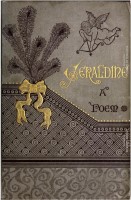
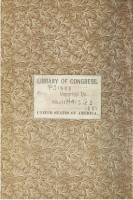
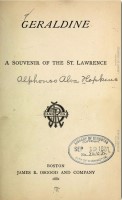
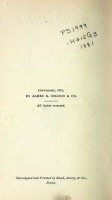
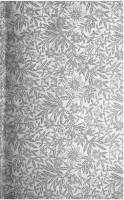
[1883]:

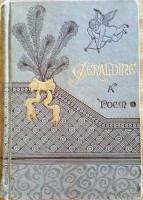
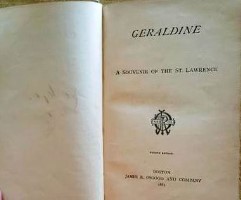
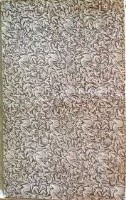
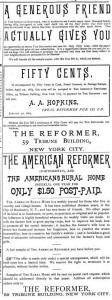
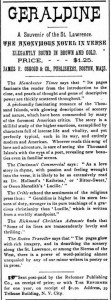
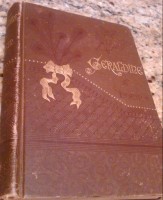
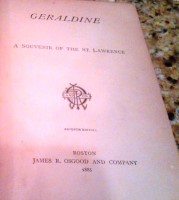
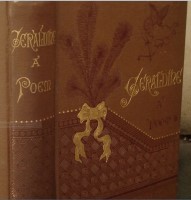
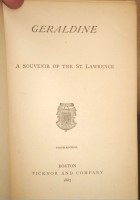
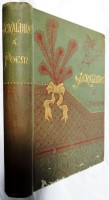

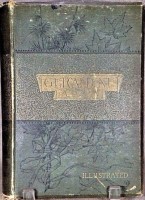
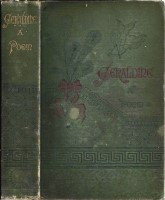
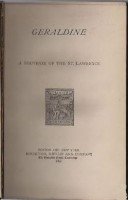
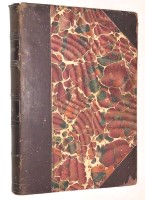
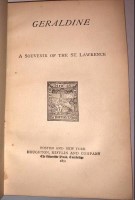
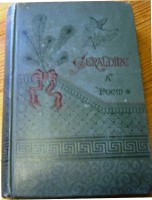
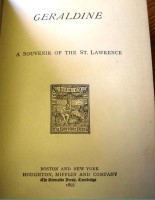
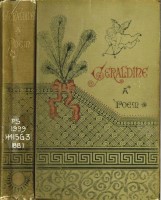
All copies have 316 text pages and a dual copyright notice: 1881 Osgood for the text, 1887 Ticknor & Co. for the illustrations.
"Eudora," issued by the J. B. Lippincott Co. is a Tale of Love, by H. B. M. Tolland, the author of "Aegle and the Elf,” etc., with drawings by Mr. H. Siddons Mowbray and Mr. Hamilton Gibson, engraved on wood. The handsome headbands used elsewhere in this number are from this book. Eudora is a maiden of noble presence, lovely and refined, with rare grace, of Grecian features and large dreamy eyes. Her story, like that of Geraldine, is told in verse, and has the added charm of rich and appropriate illustrations.
To insure accuracy, an artist was directed to follow the route of the lovers in propria persona, and the result is that these drawings are vivid reproductions of the pages of the book of nature as studied by him. These sketches of actual life, together with the page decorations strewn through the book, give it an interior of peculiar interest.
In addition to the charm imparted by this air and aspect of life and reality, the publishers were fortunate in the selection of the artist (F. Myrick) for the initials and page ornaments. They are light, airy and graceful, full of originality and feeling, mellow enough in outline to sink into the coloring of the text and yet strongly enough tinted to add to the effect of the whole. The initials on pages 159 and 160 and the five smaller tail-pieces reproduced on page 167 are taken from the pages of "Geraldine," and give a faint idea of Mr. Myrick's delicacy of conception and playfulness of fancy. Naturally, they lose greatly when transplanted, for wherever found they are part of the appurtenances."
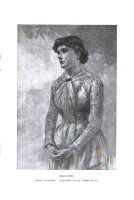
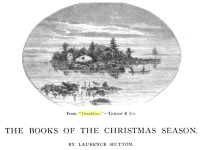
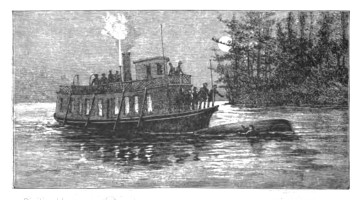
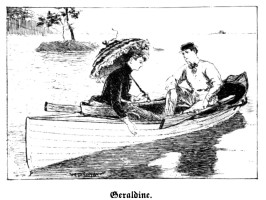
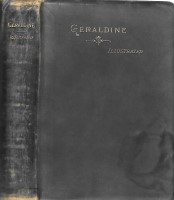
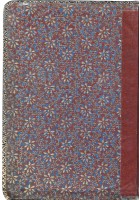
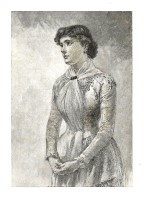
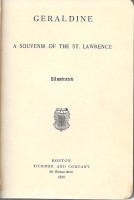
1890: RPB, MH, OO
1891: OOxM, HT]
